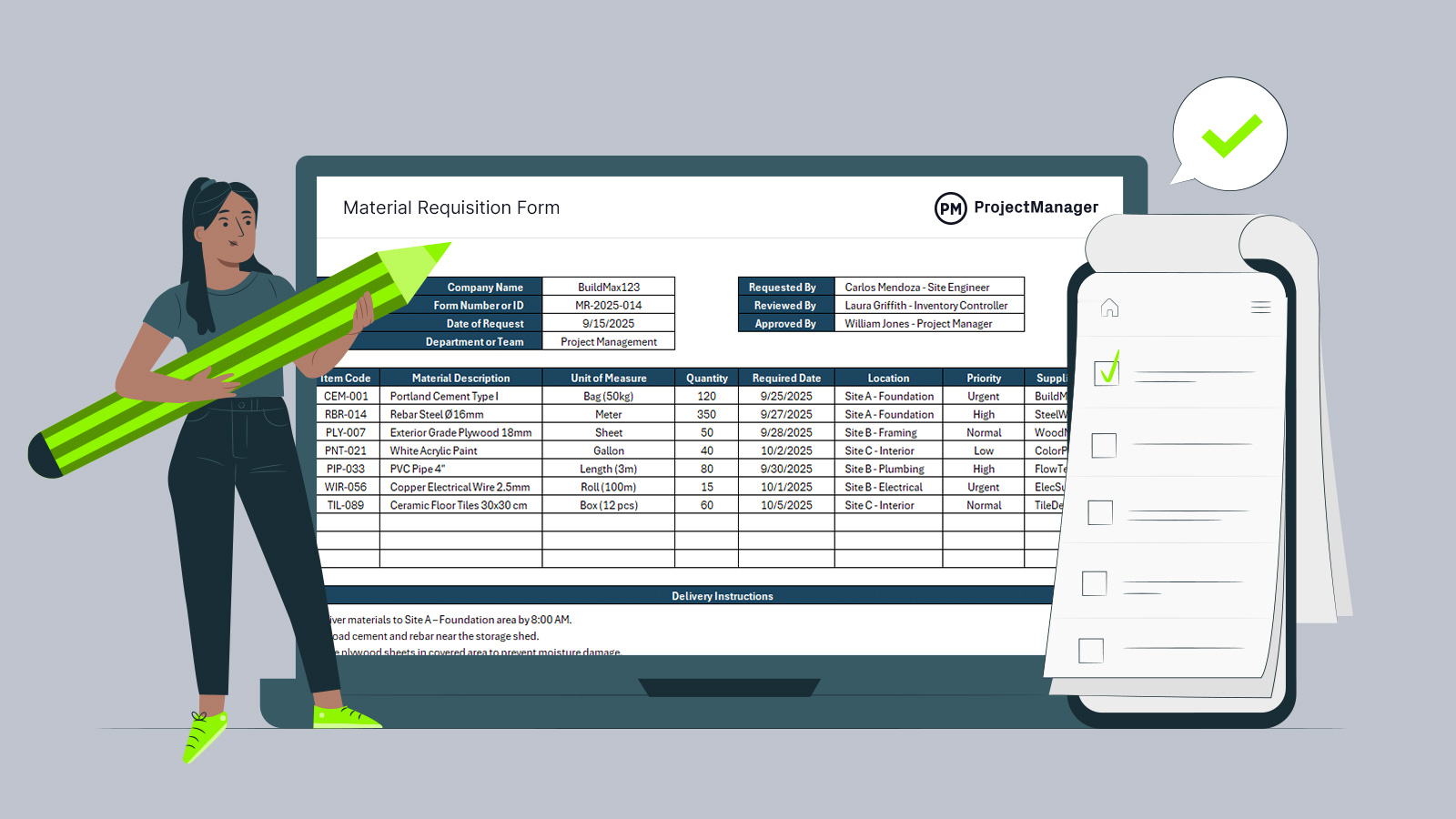A material requisition form is a document that teams use to formally request the materials, parts or supplies needed for a project or production process. It specifies the item name, quantity required, delivery date and other details that allow purchasing or inventory teams to fulfill the request accurately. This document ensures there’s a clear record of material needs, helps track usage and prevents delays caused by missing supplies.
Using a material requisition form also creates accountability and improves communication between departments. It provides visibility into which projects are consuming resources, helps manage stock levels and supports budget control. Whether you work in construction, manufacturing or any field that relies on physical materials, having a consistent process for requesting them keeps operations running smoothly and avoids last-minute shortages.
While a simple material requisition form is useful, project management software makes the process more efficient. Instead of relying on static documents that must be manually updated, software connects requests to live project schedules, budgets and inventory data. This ensures that approvals, procurement and delivery are tracked in real time and integrated into the larger project workflow.
ProjectManager is the ideal tool for managing material requisitions because it ties material requests directly to tasks, resources and costs. With Gantt charts, you can schedule when materials are needed, link dependencies to avoid bottlenecks and set baselines to track cost and schedule variance. Real-time dashboards give immediate visibility into material usage and spending, while customizable reports make it easy to share updates with stakeholders. Our software helps to streamline your material requisition process and keep projects on track. Get started with ProjectManager today for free.
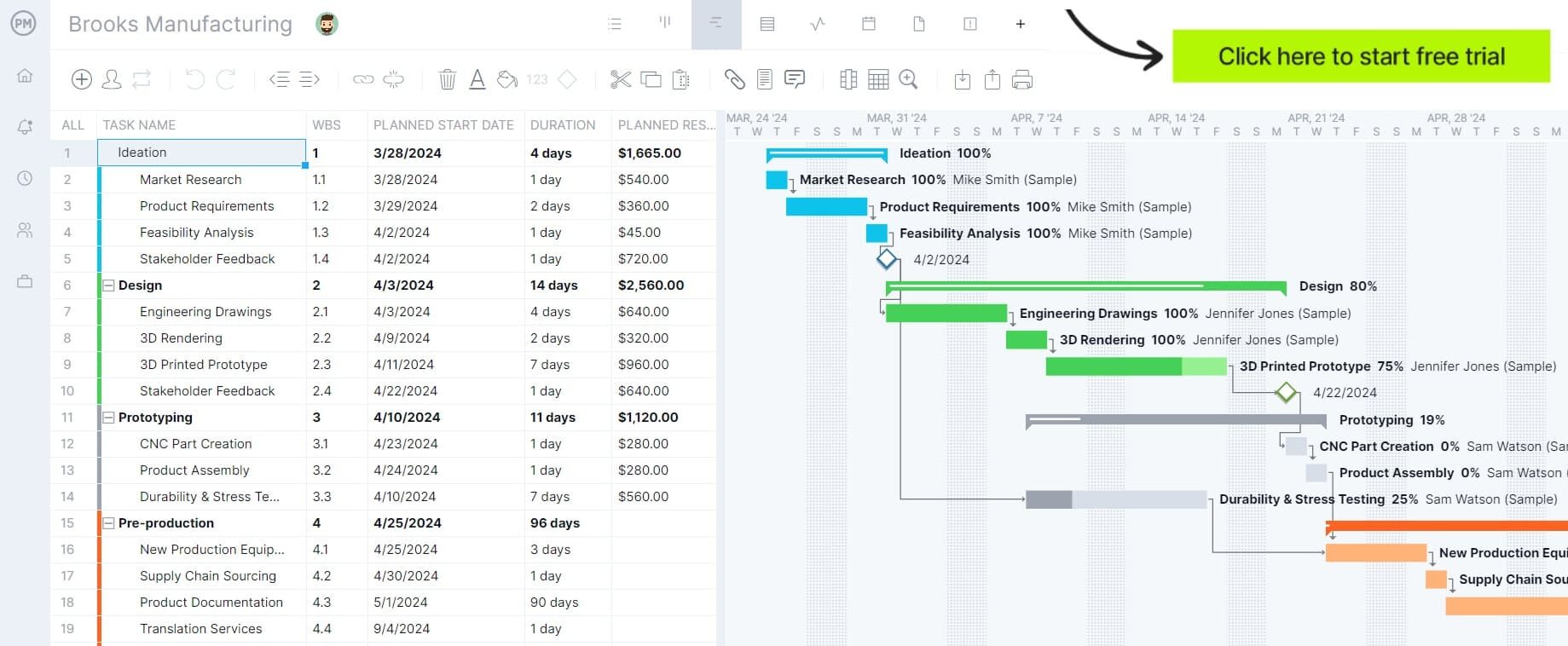
Why You Need a Material Requisition Form
A material requisition form is essential for maintaining order and efficiency when requesting supplies. It provides a clear, standardized process for communicating exactly what materials are needed, in what quantities and by when. This minimizes the risk of miscommunication between project teams, purchasing and inventory management. A formal record also helps prevent duplicate requests, ensures accurate cost tracking and supports auditing and compliance requirements.
Beyond improving accuracy, a material requisition form helps manage costs and timelines. By documenting requests, teams can better forecast material usage, avoid overspending and reduce waste. Having this process in place supports project planning, ensures materials are delivered on time and keeps operations running without interruption.
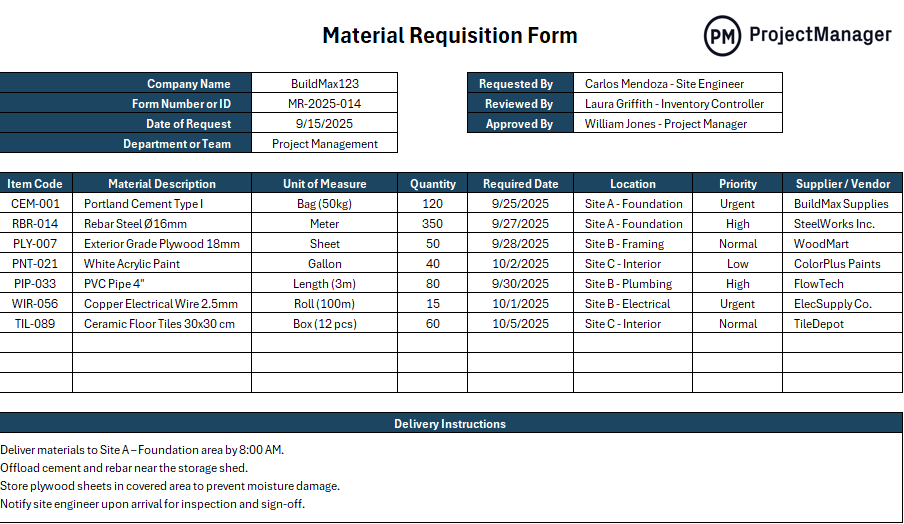
When to Use a Material Requisition Form
Material requisition forms are used whenever teams need to request items from inventory or purchase new materials. They are especially valuable in projects with tight schedules, limited budgets or strict quality requirements, where tracking every item is critical to success.
Construction Projects
In construction, material requisition forms are used to request building materials like concrete, steel, lumber and fixtures. They help site managers coordinate deliveries with project schedules so materials arrive just in time and work continues without delays. This process also helps track costs and ensures each project phase has the resources it needs.
Manufacturing Operations Projects
For manufacturing teams, material requisition forms help control the flow of raw materials, components and tools to the production floor. They ensure that production lines have what they need to stay on schedule while maintaining accurate inventory records. This is key for preventing downtime, managing supply chain efficiency and keeping production costs under control.
Who Should Use This Free Material Requisition Form?
Anyone responsible for requesting, approving or tracking materials in construction or manufacturing can use a material requisition form. It keeps communication clear between teams, prevents delays and ensures resources are available when needed. Below are some of the key roles that rely on this document and how they use it.
Construction
- Site Engineer: Uses the form to specify technical details for materials, ensuring the right specifications are met for structural integrity and project quality.
- Foreman or Supervisor: Requests materials needed for daily tasks and coordinates deliveries to keep crews productive and avoid downtime.
- Project Manager: Reviews and approves requests to ensure they align with the project plan, budget and schedule.
- Procurement Officer: Uses approved forms to place purchase orders with suppliers, negotiating prices and delivery timelines.
- Inventory Controller: Tracks requested materials against current stock, preventing overordering and maintaining accurate inventory levels.
Manufacturing
- Production Supervisor: Submits requisitions to keep the production line supplied with raw materials, avoiding stoppages and maintaining output.
- Line Manager or Shift Lead: Requests materials specific to their shift’s production run, ensuring smooth operations and meeting quotas.
- Planning & Scheduling Officer: Uses the form to forecast material needs based on production schedules and adjust orders for efficiency.
- Warehouse Manager: Fulfills requisitions by picking and dispatching the right materials to the shop floor promptly.
- Procurement Manager: Consolidates requisitions to manage supplier relationships, optimize purchasing and control overall material costs.
How to Use This Material Requisition Form for Excel
Follow these simple step-by-step instructions to make the most out of this form.
1. Fill Out the General Information
Begin by entering general information at the top of the material requisition form. Record the company name, the person requesting the materials, the individual reviewing the request, the approver, the department or team, and the date of the request. This ensures clear accountability and tracking for material orders.

2. List the Required Materials
In the main table, list each material needed for the project. Include the item code and a brief description for each listed material, such as “Portland Cement Type I” or “Copper Electrical Wire 2.5mm”. Providing specific descriptions helps prevent confusion during procurement.
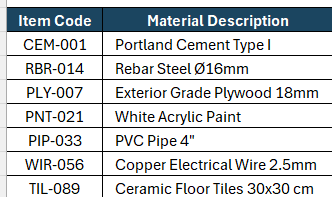
3. Define a Measurement Unit and Quantity Required for Materials
For every item, indicate the unit of measure (like “Bag (50kg),” “Meter,” or “Box (12 pcs)”) along with the quantity required. This detail clarifies exactly how much of each material must be supplied, which streamlines order fulfillment and inventory checks.

4. Specify the Date When the Materials Are Required and the Location
For every material, specify the required date and the location where it needs to be delivered (such as “Site A – Foundation” or “Site B – Electrical”). Setting clear deadlines and locations helps coordinate timely delivery to the right project areas.

5. Define Delivery Instructions
At the bottom of the form, write precise delivery instructions. For example, direct that materials be delivered to a certain site area by a specified time and include details about where to offload or store each material. Mention any special instructions, like storing plywood in a covered area or notifying the site engineer for inspection and sign-off on arrival.
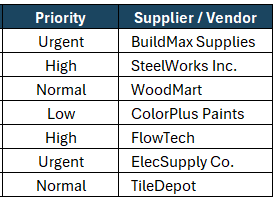
Free Related Manufacturing Templates
Along with the material requisition form, these free manufacturing templates can help streamline operations, track resources and manage production processes more efficiently. Each template is designed for easy use in Excel or Google Sheets, providing a ready-to-go framework that teams can customize to fit their workflow.
Inventory Template
This template allows manufacturers to track stock levels, item locations and reorder status in an organized format. It helps monitor raw materials, components and finished goods, preventing stockouts and ensuring smooth production. With an inventory template, teams can maintain accurate records, optimize supply levels and plan future purchases effectively.
SIPOC Template
The SIPOC template maps the entire production process from Suppliers, Inputs, Process, Outputs to Customers. It’s a high-level view that helps teams understand process flows, identify bottlenecks and improve efficiency. Using this template, managers can align operations with business goals and ensure every step of the process adds value.
Bill of Materials Template
This template is used to list all materials, components and quantities required to produce a product. It provides a clear breakdown for manufacturing teams and procurement staff, helping to plan purchases, track costs and manage inventory. A bill of materials template ensures nothing is overlooked and production runs without interruptions.
How ProjectManager Helps with Construction and Manufacturing Projects
Managing construction and manufacturing projects requires juggling multiple tasks, resources and timelines simultaneously. ProjectManager offers multiple project views, including list, kanban, sheet, calendar and Gantt chart, so teams can see the work from different perspectives and stay aligned. These views allow managers to switch seamlessly between high-level overviews and detailed task tracking, making it easier to prioritize work and spot potential issues before they become problems.
Optimize Resource Management and Reduce Bottlenecks
Resource management is a common challenge in construction and manufacturing, where delays often occur due to overbooked personnel or unavailable materials. ProjectManager solves this by providing tools to plan workloads, allocate resources efficiently and visualize team capacity with color-coded charts. Managers can see who is available, who is overextended and make real-time adjustments to prevent bottlenecks. This ensures projects stay on schedule while maximizing productivity and reducing downtime.
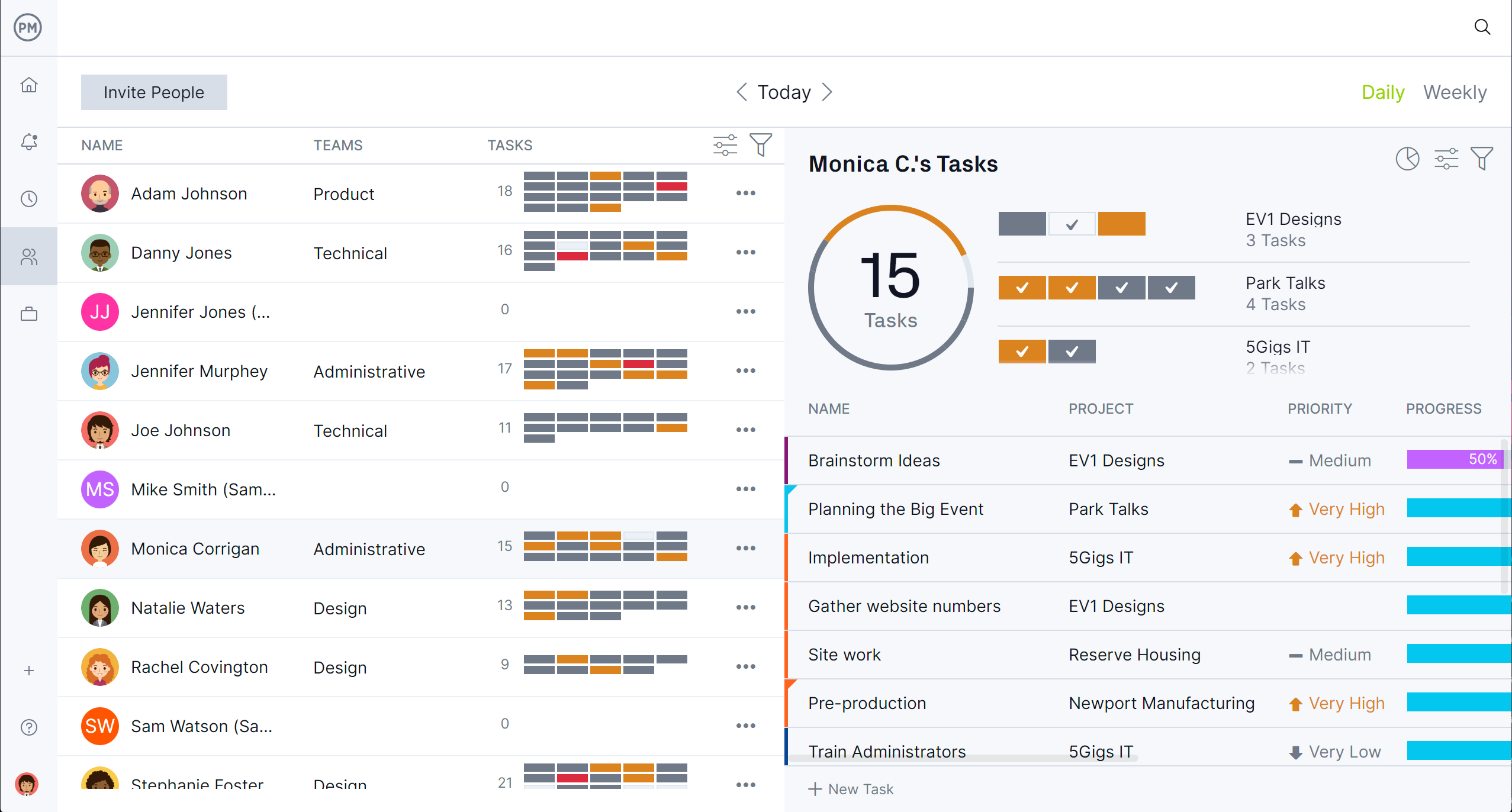
Track Progress and Ensure Timely Delivery
Tracking project progress is often fragmented when relying on spreadsheets or static templates, leading to missed deadlines and hidden risks. ProjectManager centralizes tracking with real-time dashboards, customizable reports and timesheets that update automatically. Task dependencies, milestones and progress bars are clearly displayed, making it simple to identify delays and take corrective action. With these features, managers gain complete visibility into project performance, enabling informed decisions and on-time delivery.

Related Manufacturing and Construction Content
For readers who want more manufacturing and construction content beyond a material requisition form, check out the links below. There are recently published blogs on material requirements planning, how to make a material schedule for construction and more.
- Material Requirements Planning (MRP): A Quick Guide
- How to Make a Material Schedule for Construction
- Material Takeoff (MTO) in Construction: A Quick How-to Guide
- What Is a Bill of Materials? (Example & Template Included)
ProjectManager is online project and portfolio management software that connects teams, whether they’re in the office or out in the field. They can share files, comment at the task level and stay updated with email and in-app notifications. Get started with ProjectManager today for free.
